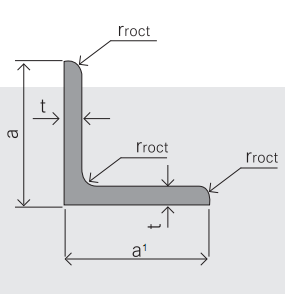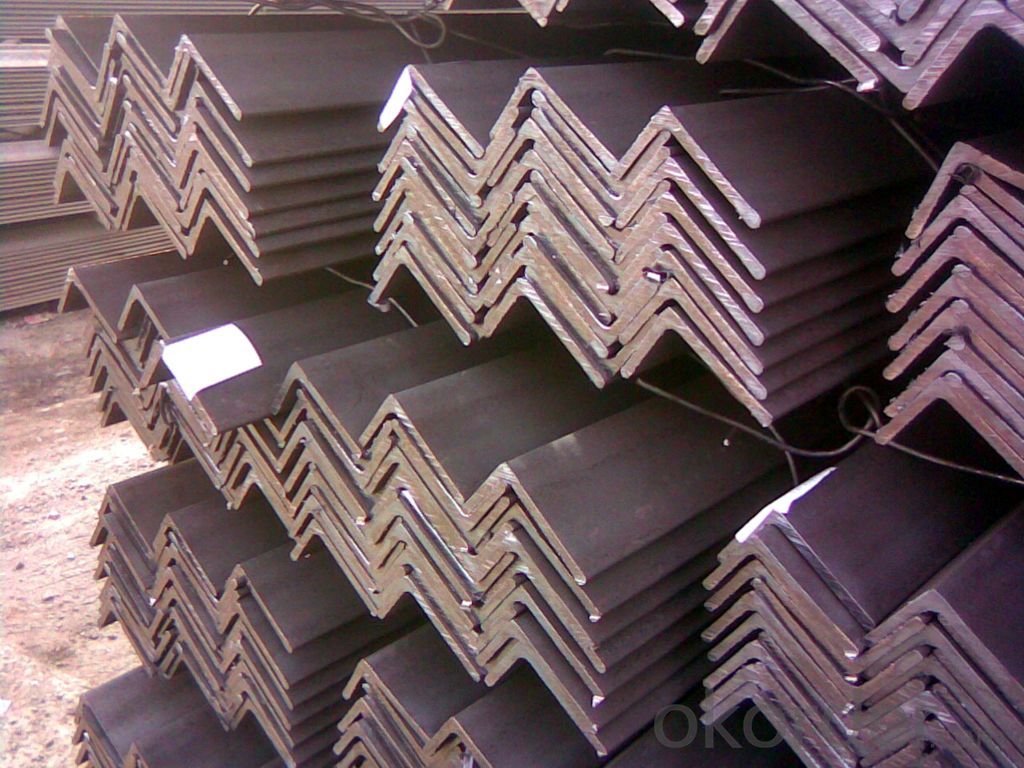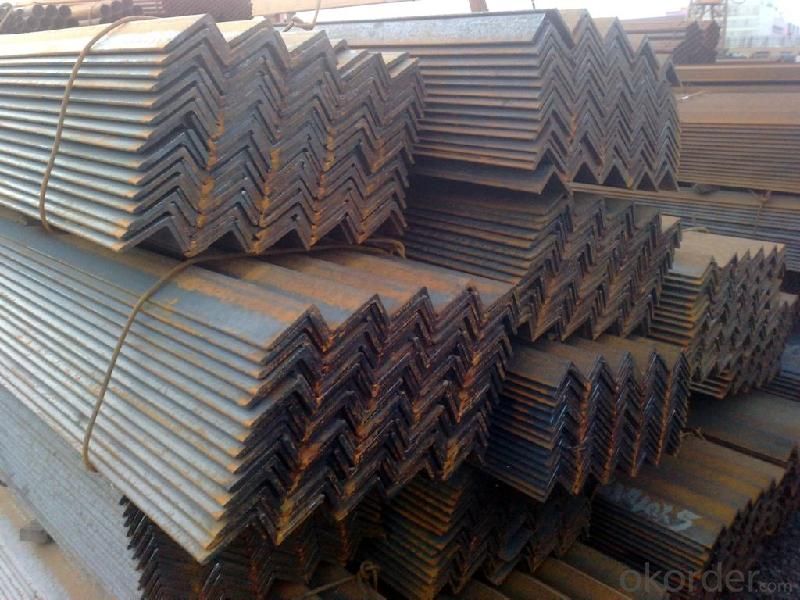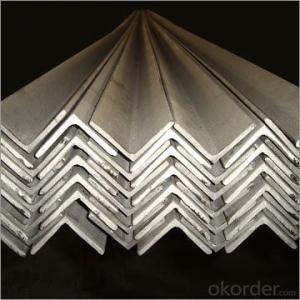S235JR Equal steel angle for construction
- Loading Port:
- Tianjin
- Payment Terms:
- TT or LC
- Min Order Qty:
- 25 m.t.
- Supply Capability:
- 100000 m.t./month
OKorder Service Pledge
OKorder Financial Service
You Might Also Like
Product Description:
OKorder is offering S235JR Equal steel angle for construction at great prices with worldwide shipping. Our supplier is a world-class manufacturer of steel, with our products utilized the world over. OKorder annually supplies products to European, North American and Asian markets. We provide quotations within 24 hours of receiving an inquiry and guarantee competitive prices.
Product Applications:
S235JR Equal steel angle are ideal for structural applications and are widely used in the construction of buildings and bridges, and the manufacturing, petrochemical, and transportation industries.
Product Advantages:
OKorder's Steel angle are durable, strong, and resist corrosion.
Main Product Features:
· Premium quality
· Prompt delivery & seaworthy packing (30 days after receiving deposit)
· Corrosion resistance
· Can be recycled and reused
· Mill test certification
· Professional Service
· Competitive pricing
Product Specifications:
1. Invoicing on theoretical weight or actual weight as customer request
2. Length: 6m, 9m, 12m
3. Material:Material: GB Q235B, Q345B or Equivalent; ASTM A36; EN 10025, S235JR, S355JR; JIS G3192, SS400;
SS540.
4.Sizes:

Sizes: 25mm-250mm | ||
a*t | ||
25*2.5-4.0 | 70*6.0-9.0 | 130*9.0-15 |
30*2.5-6.6 | 75*6.0-9.0 | 140*10-14 |
36*3.0-5.0 | 80*5.0-10 | 150*10-20 |
38*2.3-6.0 | 90*7.0-10 | 160*10-16 |
40*3.0-5.0 | 100*6.0-12 | 175*12-15 |
45*4.0-6.0 | 110*8.0-10 | 180*12-18 |
50*4.0-6.0 | 120*6.0-15 | 200*14-25 |
60*4.0-8.0 | 125*8.0-14 | 250*25 |
5.aterial details:
Alloy No | Grade | Element (%) | |||||
C | Mn | S | P | Si | |||
|
|
|
|
|
|
| |
Q235 | B | 0.12—0.20 | 0.3—0.7 | ≤0.045 | ≤0.045 | ≤0.3 | |
|
|
|
|
|
|
| |
Alloy No | Grade | Yielding strength point( Mpa) | |||||
Thickness (mm) | |||||||
≤16 | >16--40 | >40--60 | >60--100 | ||||
≥ | |||||||
|
|
|
|
|
| ||
Q235 | B | 235 | 225 | 215 | 205 | ||
Alloy No | Grade | Tensile strength (Mpa) | Elongation after fracture (%) | ||||
Thickness (mm) | |||||||
| ≤16 | >16--40 | >40--60 | >60--100 | |||
≥ | |||||||
|
|
|
|
|
|
| |
Q235 | B | 375--500 | 26 | 25 | 24 | 23 | |
Usage & Applications of GB Equal Structural Angle
According to the needs of different structures, Angle can compose to different force support component, and also can be the connections between components. It is widely used in various building structures and engineering structures such as roof beams, bridges, transmission towers, hoisting machinery and transport machinery, ships, industrial furnaces, reaction tower, container frame and warehouse etc.

Packaging & Delivery of GB Equal Structural Angle
1. Transportation: the goods are delivered by truck from mill to loading port, the maximum quantity can be loaded is around 40MTs by each truck. If the order quantity cannot reach the full truck loaded, the transportation cost per ton will be little higher than full load.
2. With bundles and load in 20 feet/40 feet container, or by bulk cargo, also we could do as customer's request.
3. Marks:
Color mark: There will be color marking on both end of the bundle for the cargo delivered by bulk vessel. That makes it easily to distinguish at the destination port.
Tag mark: There will be tag mark tied up on the bundles. The information usually including supplier logo and name, product name, made in China, shipping marks and other information request by the customer.
If loading by container the marking is not needed, but we will prepare it as customer request.

FAQ:
Q1: How soon can we receive the product after purchase?
A1: Within three days of placing an order, we will begin production. The specific shipping date is dependent upon international and government factors, but is typically 7 to 10 workdays.
Q2: What makes stainless steel stainless?
A2: Stainless steel must contain at least 10.5 % chromium. It is this element that reacts with the oxygen in the air to form a complex chrome-oxide surface layer that is invisible but strong enough to prevent further oxygen from "staining" (rusting) the surface. Higher levels of chromium and the addition of other alloying elements such as nickel and molybdenum enhance this surface layer and improve the corrosion resistance of the stainless material.
- Q:What are the maintenance requirements for steel angles?
- The maintenance needs of steel angles can differ depending on the environment and conditions they are exposed to. However, there are general guidelines that should be followed to ensure their durability and functionality. Firstly, it is crucial to regularly inspect steel angles for any signs of damage or corrosion. This can be done by visually examining the angles and checking for discoloration, rust, or surface irregularities. If any issues are found, they should be addressed promptly to prevent further deterioration. Regularly cleaning the steel angles is also essential. A mild detergent or soap solution and a soft cloth or sponge can be used for this purpose. It is important to avoid using abrasive cleaners or tools that can scratch the surface of the angles. After cleaning, the angles should be rinsed thoroughly with clean water and dried completely to prevent moisture accumulation. To protect the steel angles from corrosion, it is recommended to apply a protective coating or paint. This can create a barrier against moisture and other corrosive elements. It is important to choose a coating or paint specifically designed for steel and suitable for the environment in which the angles are used. Regular inspection and touch-up of the coating or paint may be necessary to ensure its effectiveness. Additionally, it is crucial to prevent prolonged exposure to harsh chemicals or corrosive substances that can harm the steel angles. If the angles are installed in an environment where contact with such substances is possible, appropriate protective measures, such as chemical-resistant coatings or barriers, should be employed. Finally, it is advisable to follow any specific maintenance recommendations provided by the manufacturer or supplier of the steel angles. They may have additional guidelines or requirements based on the specific type or grade of steel being used. By adhering to these maintenance requirements, steel angles can remain in good condition, maintain their structural integrity, and deliver long-lasting performance.
- Q:Can steel angles be used for door frames?
- Yes, steel angles can be used for door frames. Steel angles are commonly used in construction for their strength and durability. They provide a solid and stable support for the door frame, ensuring its stability and longevity. Additionally, steel angles can be easily customized and cut to fit the required dimensions of the door frame. They are also resistant to warping, rotting, and termite damage, making them an ideal choice for door frames. Overall, steel angles offer a reliable and practical solution for door frame construction.
- Q:What is the maximum thickness of a steel angle?
- The manufacturing process and application requirements typically determine the maximum thickness of a steel angle. Generally, steel angles can have a thickness ranging from 1/8 inch to several inches. However, it is crucial to acknowledge that the availability of thicker steel angles may differ based on the supplier and the grade of steel utilized. To ascertain the maximum thickness of a steel angle for a specific project, it is advisable to seek counsel from a structural engineer or a steel supplier who can offer guidance considering the requisite requirements and load-bearing capacities.
- Q:Can steel angles be used as reinforcement in concrete slabs?
- Concrete slabs can indeed benefit from the use of steel angles for reinforcement. These L-shaped structural steel components, commonly utilized in construction due to their durability and strength, can significantly enhance the load-bearing capacity of a concrete slab. Furthermore, they help prevent any potential cracks or structural failure. Specifically, steel angles provide added support and strength to the concrete, especially in areas where heavy loads or concentrated forces are anticipated. By incorporating steel angles as reinforcement, the concrete slab becomes more resistant to bending, tension, and shearing forces, resulting in a structurally sound slab that can withstand higher loads. It is crucial to ensure the proper design and placement of steel angles, following the guidelines and specifications provided by structural engineers, to guarantee the optimal reinforcement and performance of the concrete slab.
- Q:Can steel angles be used for signage or billboards?
- Yes, steel angles can be used for signage or billboards. Steel angles are versatile and durable, making them suitable for various applications, including signage and billboards. They provide structural support and stability, ensuring that the signage or billboard remains securely in place. Additionally, steel angles can be easily customized and fabricated to meet specific design requirements. They can be painted or coated to enhance their appearance and protect against corrosion, ensuring longevity and durability for outdoor installations. Overall, steel angles are a reliable and practical choice for signage and billboards.
- Q:Are steel angles corrosion-resistant?
- Yes, steel angles are corrosion-resistant due to the protective oxide layer that forms on their surface, which helps prevent rusting and degradation.
- Q:What are the different types of steel angles used in signage structures?
- There are several different types of steel angles that are commonly used in signage structures. These angles are used to provide structural support and stability to the signage, ensuring that it remains in place and can withstand various weather conditions. 1. Equal Angles: Equal angles, also known as L-shaped angles, have equal sides and are commonly used in signage structures. These angles provide a strong and sturdy framework for the signage, allowing it to withstand wind and other external forces. 2. Unequal Angles: Unequal angles, as the name suggests, have sides of unequal length. These angles are often used in signage structures where different sides of the signage require varying levels of support. Unequal angles can be tailored to meet specific design requirements and can provide added stability to the signage. 3. Hollow Structural Sections (HSS): HSS angles are steel angles that have a hollow interior. These angles are widely used in signage structures due to their lightweight nature and high strength-to-weight ratio. HSS angles are especially useful when constructing large and complex signage structures, as they help reduce the overall weight and allow for easier installation. 4. Corner Angles: Corner angles are used to reinforce the corners of signage structures, providing additional support and preventing any potential bending or warping. These angles are typically made from thicker steel and are designed to withstand high levels of stress and pressure. 5. Galvanized Angles: Galvanized angles are steel angles that have been coated with a layer of zinc to protect them from rust and corrosion. These angles are commonly used in outdoor signage structures, where they are exposed to moisture and other environmental elements. The galvanized coating ensures the longevity and durability of the angles, prolonging the lifespan of the signage structure. Overall, the choice of steel angles used in signage structures depends on factors such as the size and design of the signage, the expected load and stress, and the environmental conditions. By selecting the appropriate type of steel angle, signage structures can be built to withstand the rigors of outdoor environments and provide long-lasting support for various types of signage.
- Q:Are steel angles resistant to corrosion?
- Yes, steel angles are resistant to corrosion due to the protective oxide layer that forms on their surface, which helps prevent rusting and deterioration over time.
- Q:How do you calculate the effective length of a steel angle?
- To calculate the effective length of a steel angle, you need to consider its end conditions and support conditions. It is determined by analyzing the buckling behavior and stability of the angle under different loading conditions. This involves considering factors such as fixed or pinned ends, bracing conditions, and the angle's geometric properties. By applying relevant formulas or structural analysis methods, you can determine the effective length and use it to assess the angle's structural stability and design requirements.
- Q:What is the meaning of the number of angle steel
- The two sides of an equal angle steel are equal in width. The specifications are expressed in millimeters of edge width * edge width * edge thickness. Such as "/ 30 x 30 x 3", that is 30 mm width equal angle, edge thickness of 3 mm. The model can also be used, also the title number, number is the number of centimeters wide, such as the No. 3 angle angle 3#.
1. Manufacturer Overview |
|
|---|---|
| Location | |
| Year Established | |
| Annual Output Value | |
| Main Markets | |
| Company Certifications | |
2. Manufacturer Certificates |
|
|---|---|
| a) Certification Name | |
| Range | |
| Reference | |
| Validity Period | |
3. Manufacturer Capability |
|
|---|---|
| a)Trade Capacity | |
| Nearest Port | |
| Export Percentage | |
| No.of Employees in Trade Department | |
| Language Spoken: | |
| b)Factory Information | |
| Factory Size: | |
| No. of Production Lines | |
| Contract Manufacturing | |
| Product Price Range | |
Send your message to us
S235JR Equal steel angle for construction
- Loading Port:
- Tianjin
- Payment Terms:
- TT or LC
- Min Order Qty:
- 25 m.t.
- Supply Capability:
- 100000 m.t./month
OKorder Service Pledge
OKorder Financial Service
Similar products
New products
Hot products
Related keywords




























